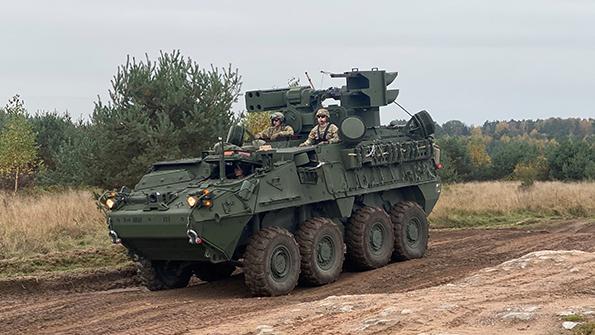This article is published in Aviation Week & Space Technology and is free to read until Jun 12, 2024. If you want to read more articles from this publication, please click the link to subscribe.
Opinion: Strengthen The Defense Sector’s ‘Middle Ground’

The Maneuver–Short-Range Air Defense system.
The Pentagon’s National Defense Industrial Strategy expresses the imperative of “strengthening and modernizing our defense industrial base ecosystem” and sets priorities for meeting those challenges. Efforts to address these priorities can gain leverage from midsize, or middle-ground, defense companies, which are a key source of innovation, resilience and agility. Public policies and corporate strategies alike should act to strengthen this middle ground.
In ecology, “middle ground” is the land that buffers and intermediates the needs of pristine nature and human-dominated spaces. In a healthy defense industrial ecosystem, companies occupying the middle ground—between the many small companies and varied range of large ones—likewise perform important systemic roles.
Today, the defense industrial base (DIB) is at an inflection point marking the end of its post-Cold War generation. As the wars in Ukraine and Gaza starkly demonstrate, the application of numerous cheap advanced technologies to the brutal grind of high-intensity combat is increasing the pace and lethality of war and changing what militaries require of industry. Modern militaries need more production capacity, more rapid adoption of innovations and more secure and efficient supply chains than an industry optimized to post-Cold War strategies is delivering. The still greater challenge of resetting our military forces to deter China only amplifies these needs.
Measured against these imperatives, the current structure of the DIB is imbalanced and inefficient. Figuratively, it resembles a saddle with a large number of small, narrowly scoped companies gathered at one end and a few large, diversified companies clustered at the other, with just a handful of middle-ground companies in between. The result is what the National Defense Industrial Strategy politely calls “systematic challenges”—from slow adoption of commercial technology, weak cultivation of talent and insecure supply nodes to obsolete manufacturing practices, financially frail upstream suppliers and limited integration of allies’ technology and industrial capabilities.
Within that challenged ecosystem, middle-ground companies are navigating through these problems. They comprise fewer than 20 of the 100 largest companies by revenue but play a diversity of roles. They are technology integrators, such as AM General, General Atomics and Leonardo DRS; business units of the multi-industrials, such as Textron Systems and GM Defense; subsystem specialists, such as Mercury Systems and Curtiss-Wright; and government services specialists, such as Mantech and Maxar Intelligence.
Just as in ecology, the defense industry’s middle ground should be regarded as an essential source of vitality and resilience in the defense-industrial ecosystem that emerges from this inflection point. They are engines of innovation, adapting commercial and allied technologies to military needs; they work closely with customers to develop and manufacture urgent capabilities quickly. And because they are largely unencumbered by vertical integration, they bring opportunity to best-of-breed component manufacturers and provide competitive subsystems to the prime integrators.
However, starting from its contemporary structure, the industry that emerges in response to today’s industrial-strategic imperatives is not likely to reconstitute a large cohort of middle-ground companies at its core. As such, its place in the industrial structure should be strengthened and impediments to its expansion mitigated through public policies and corporate strategies.
Pentagon acquisition executives can foster the middle ground by promoting vigorous competition up and down the supply chain. For example, they can ensure direct channels of R&D funding to the sector, discourage mergers that risk the vertical foreclosure of middle-ground capabilities and avoid buy-American reflexes that disadvantage foreign-owned U.S. companies. At the same time, the Pentagon can advance acquisition strategies that provide challenging opportunities for middle-ground companies to prove their merit.
In turn, captains of industry can take actions that preserve and perfect the middle-ground companies’ structural advantages: sustain merchant-supplier practices that allow platform-agnostic capabilities to flow freely through the middle ground, actively manage portfolios of assets and burden of overhead to maintain efficiency and invest to differentiate by speed and responsiveness.
As ecologists say, when the middle ground is healthy, the ecosystem thrives. Strengthening the middle ground of the defense sector that emerges on the other side of the industry’s inflection point should be a key workstream in the implementation of the National Defense Industrial Strategy.
William J. Lynn III is a former U.S. deputy defense secretary and current CEO of Leonardo DRS. Steve Grundman is a senior fellow at the Atlantic Council and former deputy under secretary of defense for industrial affairs and installations.




